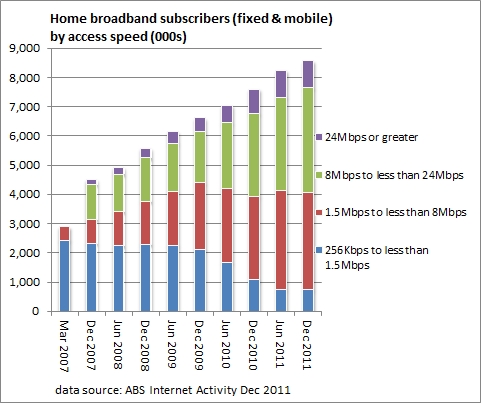By the numbers: AU's 2-speed internet economy

The latest data from the Australian Bureau of Statistics (ABS) shows demand for broadband to be increasing, with two clear demands: mobility and speed.
The ABS published its latest Internet Activity report on Friday, showing that the number of households connected to broadband (256Kbps or faster) grew 4 per cent in the second half of 2011.
This is largely good news because it shows that more people are signing up to a faster future. The growth isn't coming from DSL, though — that's been steady at around 4.5 million services for the last year or so. HFC and cable have moved very little (accounting for 937,000 services). The growth has come from mobile broadband, which climbed by 15 per cent over the last six months of last year.
And this rise in mobile services isn't causing a decline in DSL, so it's unlikely the growth points to fixed-to-mobile substitution. Instead, the figures seem to indicate home users are demanding faster fixed-line connections in addition to a mobile plan. Those with speeds between 8- and 24Mbps have increased in number by 12 per cent in just six months and now outnumber those with speeds between 1- and 8Mbps. The lower speeds will be used by a higher proportion of mobile customers than ever before, while the top speeds are mainly being delivered through fixed-line technologies.

(Credit: Phil Dobbie/ZDNet Australia)
If there is any fixed-to-mobile substitution going on then it's to the detriment of those choosing the mobile-only option. If this trend continues, more and more people will be enjoying fixed-line access at speeds over 8Mbps, something not regularly achieved by mobile broadband. Secondly, fixed line continues to account for 93 per cent of all data downloads and that's growing fast: the amount we downloaded via fixed lines grew by 26 per cent in the second half of last year.
But there's still some way to go; as we highlighted last week, the amount of data we download is just 12 per cent of what the average American downloads.
All this, surely, points to mobile as a poor fixed-line substitute. Those who choose the mobile-only road risk becoming locked into the slow lane of the digital future. Of course, the choice is often driven by a lack of choice — there is simply no fixed-line option. Does it make sense that, in future, the extent to which you partake in the digital economy is determined by where you live?
Thanks to the dominance of the mining sector, Australia already has a two-speed economy. Perhaps we should try to avoid perpetuating that in the digital communications world by ignoring the need for a robust fixed-line access network.